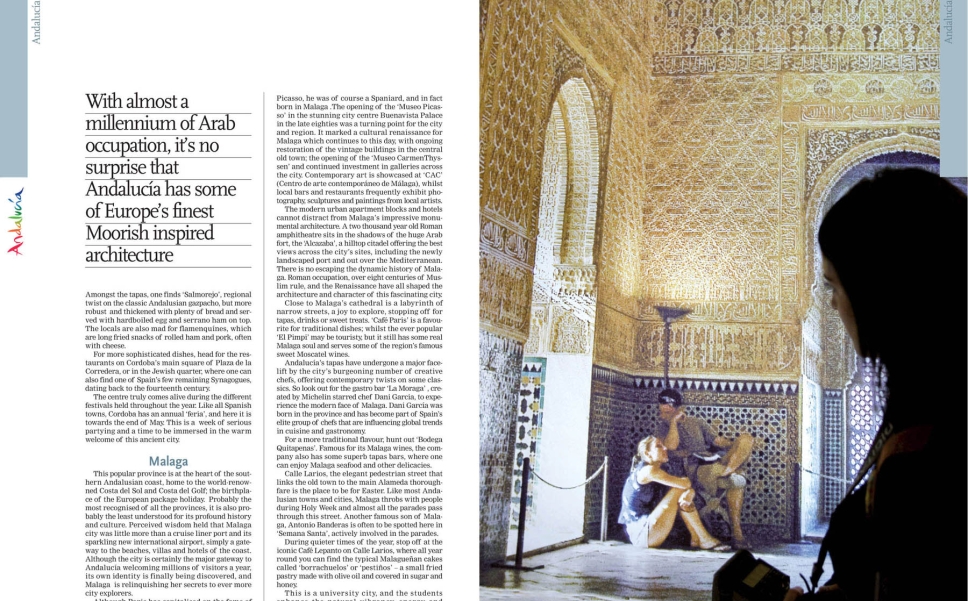Destination Marketing: Spain – Andalucia Tourism Malaga
This popular province is at the heart of the southern Andalusian coast, home to the world-renowned Costa del Sol and Costa del Golf; the birthplace of the European package holiday. Probably the most recognised of all the provinces, it is also probably the least understood for its profound history and culture. Perceived wisdom held that Málaga city was little more than a cruise liner port and its sparkling new international airport, simply a gateway to the beaches, villas and hotels of the coast. Although the city is certainly the major gateway to Andalucía welcoming millions of visitors a year, its own identity is finally being discovered, and Málaga is relinquishing her secrets to ever more city explorers.
Although Paris has capitalised on the fame of Picasso, he was of course a Spaniard, and in fact born in Málaga .The opening of the ‘Museo Picasso’ in the stunning city centre Buenavista Palace in the late eighties was a turning point for the city and region. It marked a cultural renaissance for Málaga which continues to this day, with ongoing restoration of the vintage buildings in the central old town; the opening of the ‘Museo CarmenThyssen’ and continued investment in galleries across the city. Contemporary art is showcased at ‘CAC’ (Centro de arte contemporáneo de Málaga), whilst local bars and restaurants frequently exhibit photography, sculptures and paintings from local artists.
The modern urban apartment blocks and hotels cannot distract from Málaga’s impressive monumental architecture. A two thousand year old Roman amphitheatre sits in the shadows of the huge Arab fort, the ‘Alcazaba’, a hilltop citadel offering the best views across the city’s sites, including the newly landscaped port and out over the Mediterranean. There is no escaping the dynamic history of Málaga. Roman occupation, over eight centuries of Muslim rule, and the Renaissance have all shaped the architecture and character of this fascinating city.
Close to Málaga’s cathedral is a labyrinth of narrow streets, a joy to explore, stopping off for tapas, drinks or sweet treats. ‘Café Paris’ is a favourite for traditional dishes; whilst the ever popular ‘El Pimpi’ may be touristy, it still has some real Málaga soul and serves some of the region’s famous sweet Moscatel wines.
Andalucía’s tapas have undergone a major facelift by the city’s burgeoning number of creative chefs, offering contemporary twists on some classics. So look out for the gastro bar ‘La Moraga’ , created by Michelin starred chef Dani Garcia, to experience the modern face of Málaga. Dani Garcia was born in the province and has become part of Spain’s elite group of chefs that are influencing global trends in cuisine and gastronomy.
For a more traditional flavour, hunt out ‘Bodega Quitapenas’. Famous for its Málaga wines, the company also has some superb tapas bars, where one can enjoy Málaga seafood and other delicacies.
Calle Larios, the elegant pedestrian street that links the old town to the main Alameda thoroughfare is the place to be for Easter. Like most Andalusian towns and cities, Malaga throbs with people during Holy Week and almost all the parades pass through this street. Another famous son of Málaga, Antonio Banderas is often to be spotted here in ‘Semana Santa’, actively involved in the parades.
During quieter times of the year, stop off at the iconic Café Lepanto on Calle Larios, where all year round you can find the typical Malagueñan cakes called ‘borrachuelos’ or ‘pestiños’ – a small fried pastry made with olive oil and covered in sugar and honey.
This is a university city, and the students enhance the natural vibrancy, energy and warmth of the Málaga people. Plaza Merced to the north of old town is the place for late night drinks; every evening here has the feeling of a party, with the square filled with the sound of talking and laughter.
Málaga is full of surprises, just waiting to be stumbled upon. Whether it’s the small Arab baths in old town or a quirky boutique. Head a little east from the elegant City Hall and its exquisite Moorish inspired public garden and one will reach ‘The English Cemetery’. Dating back to the early nineteenth century, this little corner of England is filled with evocative, monumental tombstones, follies and mature gardens.
From here, head towards the beach, and El Palo. This is where the city relaxes, and each lunchtime, evening and weekend the sea front bars, chiringuitos, and restaurants are full. A must is wood-fired barbequed sticks (espetos) of sardines in season. Fish is such an important part of the Malagueñan gastronomy that their nickname is ‘Los Boquerones’ – The Anchovies!
The city’s fortunes have long been linked to the sea, and Málaga’s port is strategically positioned where the Atlantic and Mediterranean meet. Today it is an increasingly popular cruise ship stop-over and normally there are at least one or two huge gleaming white vessels in the newly remodelled port, delivering international visitors from across the world, eager for a taste of what Málaga has to offer.
Of course many head off to the glitzy resort of Marbella where despite the years of development there are still some classic corners to discover, such as the iconic ‘Marbella Club Hotel’ or the bougainvillea scented narrow streets of old town. After some years of decline, Puerto Banús, once synonymous with exclusivity is restoring some of its appeal with newly opening high end eateries, and fancy bars all with views of course of those super yachts.
The province of Málaga, despite its development on the back of tourism still has some magnificent natural areas, including the Sierra de las Nieves, with its unique Pinsapo pine trees and snow capped mountains. The romantic town Ronda and its surrounding white villages, together with Antequera are unmissable destinations too, with their own rich culture, and some surprising local dishes and historic sites.
©COPYRIGHT ANDREW FORBES

















